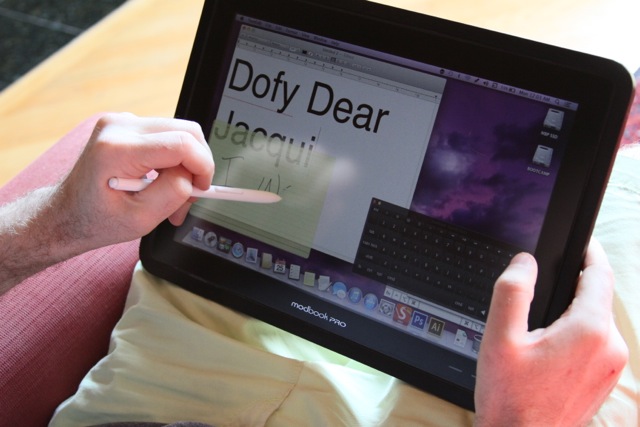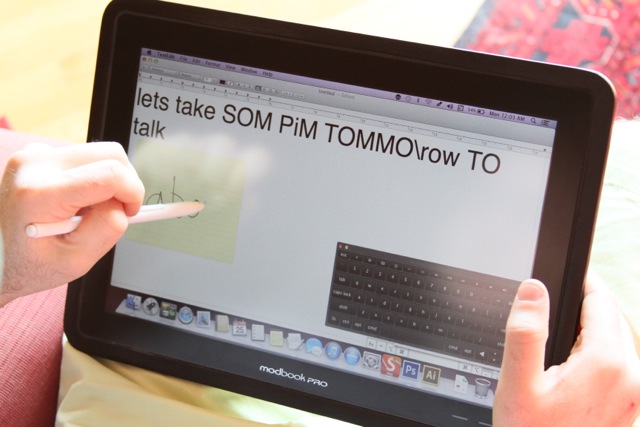As a writing device
Beyond using the device as a drawing tablet, there are other reasons you might want to use the ModBook Pro. People who are averse to typing—whether because of personal preferences or because of eye/brain issues when it comes to keyboards—may find it easier to simply write on the ModBook's screen using OS X's built-in Inkwell technology.

As I noted in 2008, the use case for this can be somewhat limited. Using Inkwell to hand-write an entire URL in Safari can be frustrating. OS X can have a hard time deciding whether you're trying to write or tap on various elements of the UI. If you're writing text in something like TextEdit or Word, however, it's a different story. As long as you have an area of the screen that you keep clear for writing and you're willing to dedicate loads of extra time to the task of writing out (and correcting) individual words, then who are we to stop you?

That said, this continues to be what I consider a fringe use of the ModBook. It's certainly possible, and if you're someone who uses Inkwell regularly, it may be a godsend. I don't see many regular Mac users suddenly switching over to Inkwell just because it's easier to use on a ModBook Pro, however. Although I'm no huge fan of pen-tapping on the on-screen keyboard, it's much easier to do that than hand-writing everything.
Battery life: Make sure to have power nearby
The ModBook Pro's battery is the same one that comes in the 13-inch MacBook Pro: a 63.5 watt-hour lithium-polymer battery. Apple advertises up to seven hours of wireless Web use on the 13-inch non-retina MacBook Pro. In our experience, the MacBook Pro is capable of being used for about that amount of time (five to eight hours, depending on your usage) and sleeping for days (if not a whole week or more) on a single battery charge.
But the ModBook Pro is a bit of a different beast. Perhaps because of the built-in Wacom digitizer, and perhaps because screen brightness has to be a bit brighter during normal use (at least for me, due to the viewing angle), the battery seems to drain a lot faster.
I didn't perform the same battery tests that I might normally perform on a notebook, because the ModBook Pro is a different kind of device. Its primary use case isn't watching movies (although you could, since there's a built-in SuperDrive) or surfing the Web, it's drawing or painting. When performing those tasks with the ModBook Pro, the battery lasted for about four hours or so depending on screen brightness and the task at hand. But four hours isn't eight hours, so you're unlikely to get away with using a ModBook all day without having power nearby.
Standby time, however, was a very different story. Putting the ModBook Pro down at 100 percent battery and picking it up the next day, I'd be greeted with 30 percent or less. There appears to be a pretty decent drain while it's asleep, even if you keep the Energy Saver settings exactly the same as you would on a MacBook Pro (I had my ModBook automatically sleep the machine and screen after five minutes of inactivity). I'm very confident that you couldn't leave the ModBook Pro for two days or more without having to recharge.
Long story short: the ModBook Pro can go for a handful of hours on its own battery, but it won't last as long—or stand by as long—as its equivalent 13-inch MacBook Pro. I don't recommend leaving it unattended without being plugged in unless you want to regularly curse at your past self when you run out of juice.
Should I buy a ModBook Pro?
If you've gotten this far in the review, it's probably because you're actually interested in the ModBook Pro's capabilities as a tablet computer. It would be almost insane to buy a ModBook Pro if you plan to use it primarily as a regular notebook—at nearly $3,500, it's $2,000 more than the equivalent hardware in MacBook Pro form from Apple. So we're not going to address that. If you want a MacBook Pro, buy a MacBook Pro. If you plan to draw only occasionally, buy an external Wacom tablet. They're great.
It's much more likely that you're wondering about whether it's worth the $3,500 price tag to buy a ModBook over something like an iPad (or an iPad equivalent from your favorite manufacturer). The answer isn't an easy one—sorry!—but there are a number of clear points that might help you decide.
You might want to buy a ModBook Pro if you need genuine computer hardware—not beefed up mobile chips—to get your work done. Perhaps you're a 3D animator or a serious Photoshop artist and you can't get your work done without at least a notebook-level machine. Or perhaps it's not so much the hardware—you need a full version of OS X (or Windows) in your tablet life because you're using software that simply doesn't exist on the slimmed down mobile tablets. In that case, it's somewhat of a no-brainer: you probably want to consider a ModBook Pro.
But if you (only) draw a lot and don't necessarily need beefy hardware in order to doodle or paint, the ModBook Pro is likely to be overkill, if for no other reason than price. There are tons of drawing and painting apps out there on the App Store nowadays, and if you're not married to the MacBook Pro hardware or a full-blown version of OS X, it seems largely unnecessary. A full-sized iPad with Wi-Fi and 64GB of storage runs $699, or 128GB of storage at $799. There's been a lot of debate over whether 128GB of storage is even necessary on a device like the iPad, but at $800, it's still considerably less than the ModBook Pro.
Plus, the iPad has the ability to tack on 3G or 4G capabilities (depending on where you live) for an extra $129 plus monthly costs. You could of course do this with the ModBook Pro using external wireless cards, but they stick out the sides and take up valuable ports—you can't get one built-in like you can on an iPad or Android tablet. And even when you get your iPad with LTE built-in, the cost is still several thousand dollars less than a ModBook Pro.
ModBook—the company—sees iPad users as future ModBook Pro users, because iPad users may become hooked on the tablet form factor and eventually want something more powerful. That may technically be true if the user in question is a creative professional or a die-hard artist. But most of us in the world aren't, and we have little need for something like a ModBook when we could just doodle on our iPads instead.
When going back to my 2008 review of the old ModBook Pro, I couldn't help but notice similarities between my conclusions then and now. The main thing that's different today compared to 2008 is that mobile tablets have taken over and filled a huge chunk of the ModBook Pro's old niche for us casual users. Now more than ever, the ModBook Pro targets the highest-end professionals. If you're not one, you're likely just burning money. But if you are one, the ModBook Pro remains the only option out there if you want to use a real Mac as a tablet computer. And for that, it's a pretty good solution.
The Good:
- Runs a full version of OS X or Windows (under Boot Camp), and all compatible software
- Creative pros will like this more than an iPad due to its large screen and the ability to rest your hands on the screen while drawing
- 1,024 levels of pen/digitizer pressure means it's particularly well-suited for drawing/painting
- USB, FireWire, Thunderbolt, SD card slot, etc. make it hugely preferable to the iPad for pros
The Bad:
- Heavy—not something you'd want to carry around all the time
- Viewing angle is optimal when straight-on, meaning you're looking directly down a lot if you're drawing
The Ugly:
- (Still) very limited as a normal notebook. Possible, but not recommended.
- Battery life. Oh god, the battery life.
reader comments
119